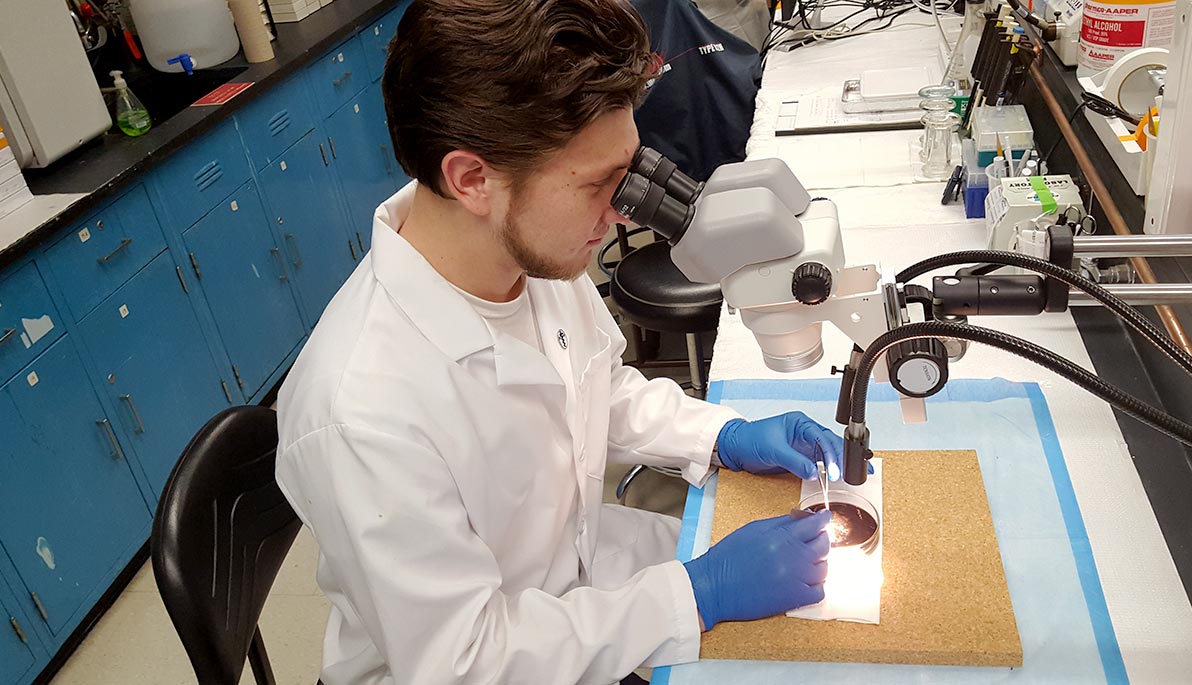News
NYITCOM Students Win Research Excellence Awards
April 4, 2016
Photo: Medical student Artur Rozentsvit does research in an NYIT lab.
Three NYIT College of Osteopathic Medicine (NYITCOM) students have won awards to present their research at the prestigious Experimental Biology Meeting in San Diego in April 2016. Artur Rozentsvit, Usman Aslam, and Chirag Parikh were among only 10 students nationwide to each win $1,800 from the American Physiological Society, which hosts the annual meeting of more than 14,000 scientists and exhibitors from around the world. Last year, two NYITCOM students won the same award.
In separate animal research projects, the students investigated various cellular processes associated with optimal heart health. Following are descriptions of their projects.
Exploring Vascular Health and Diabetes
Rozentsvit's research focused on a natural antioxidant's effect on the function of the endothelium, a part of the cell wall within blood vessels. Using rat aortas treated with a high glucose solution to mimic diabetes, he discovered that ellagic acid, commonly found in berries and nuts, improved the function of endothelium lining the aorta, the largest artery in an animal's body.
"We know that in diabetes [both Type 1 and Type 2] blood vessels do not function properly and circulation is impaired, which leads to the development of several vascular complications," said Rozentsvit, a second-year medical student. "Within hours of treating the aortas with ellagic acid, we could detect improvement of the blood vessels' function."
Working in the lab of Assistant Professor Maria Carrillo Sepulveda, Ph.D., Rozentsvit also studied human endothelial cells and saw similar results.
"Our research suggests that ellagic acid has an anti-inflammatory effect that improves vascular cells' function during diabetic conditions," he said.
The motivation for Rozentsvit's research comes from its potential to help diabetic patients. Nearly 10 percent of the U.S. population lives with diabetes and suffers from cardiovascular complications from the disease, according to the American Diabetes Society.
"My aspiration is to be a physician on the front line of medical research, so that I may administer to my patients a treatment that I can vouch for, that I helped develop," Rozentsvit wrote in his award submission essay.
Fasting and Cellular Health
In the lab of Associate Professor Qiangrong Liang, M.D., Ph.D., Aslam examined how mitochondria, the so-called "powerhouses of cells," live, die, and are regulated within cardiac muscle cells.
When mitochondria are damaged, they can adversely affect a cell's survival. Aslam's animal research demonstrated that fasting helps to remove these damaged mitochondria from cardiac cells. His research required intensive investigation into the biochemical pathways involved in autophagy, a process by which cells degrade and recycle various internal components.
In the study, Aslam subjected two groups of mice to nutrient deprivation for varying times and also kept a well-fed control group. The genetically modified mice in his experiments expressed a special type of protein which, when observed under a confocal microscope, appeared green in healthy mitochondria and red in damaged ones. Aslam also noted changes in various cellular protein levels. His data suggests that prolonged fasting has a positive effect on mitochondrial regulation. He continues to work on his project and hopes to characterize the biochemical pathway behind these observations.
"Heart disease is currently the leading cause of death in the United States and the world, which motivates me to pursue a career as a cardiologist," said Aslam, a second-year medical student and NYIT Presidential Global Fellow. "In this field, I can use my lab experience to research novel therapies to help patients with various cardiovascular ailments. Working with Dr. Liang has been immensely rewarding. His mentorship has made me a better student-scientist, and studying the cardiovascular system through biochemistry in his lab has allowed me to appreciate the human heart in a new light."
Genes and Heart Disease
Parikh, an NYITCOM Academic Medicine Scholar also working in Liang's lab, studied the MuRF1 gene and the role it plays with mitochondria and their metabolic processes in animal cardiac cells. The gene has been linked to an increased risk of heart disease.
Parikh focused on how an increased level of MuRF1 affects cells. He discovered the volume of mitochondria decrease when the amount of the gene increases.
"This is one piece of the puzzle in helping us understand what role MuRF1 may play with regulation of mitochondria," said Parikh. "The next step is to try to understand what processes MuRF1 controls and how it does so. Good research always opens up new questions to answer!"
His research could help to provide a foundation for developing drugs for people with the MuRF1 gene. Those therapies, he said, could help to improve energy production in cells, even with the gene present.
Parikh said he looks forward to sharing his research with "brilliant minds" gathered at the San Diego meeting and perhaps learning how to improve the design and techniques of his future experiments.




